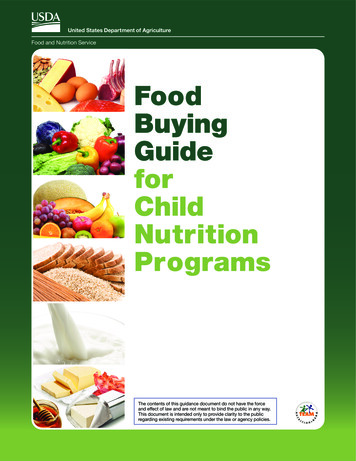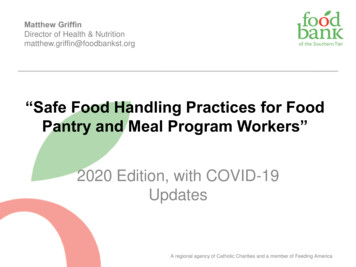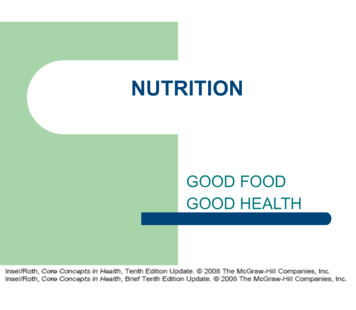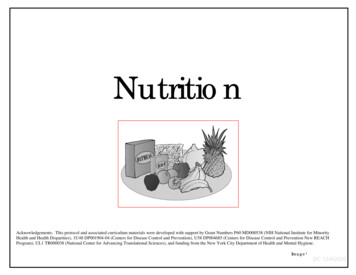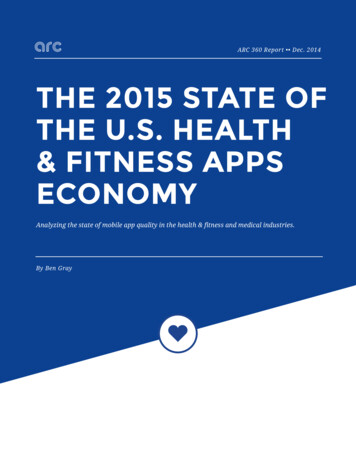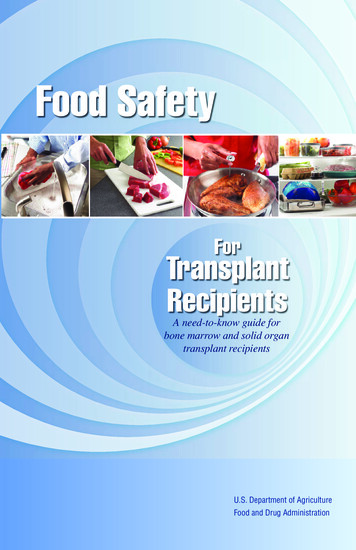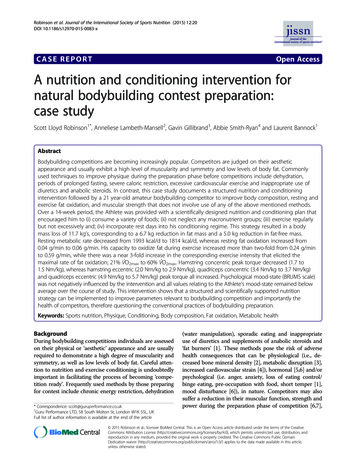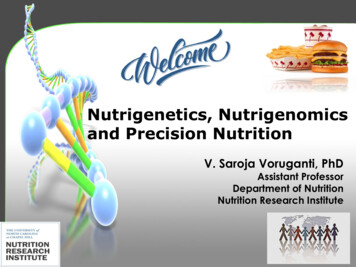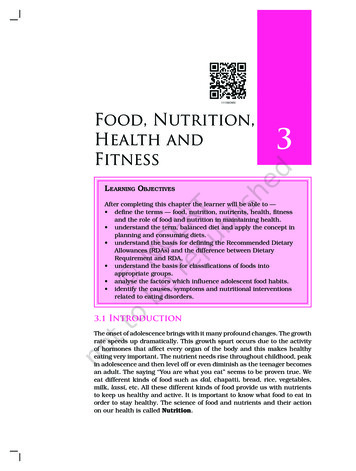
Transcription
Human Ecology and Family Sciences – Part IFood, Nutrition,Health andFitness3Learning Objectives28After completing this chapter the learner will be able to — define the terms — food, nutrition, nutrients, health, fitnessand the role of food and nutrition in maintaining health. understand the term, balanced diet and apply the concept inplanning and consuming diets. understand the basis for defining the Recommended DietaryAllowances (RDAs) and the difference between DietaryRequirement and RDA. understand the basis for classifications of foods intoappropriate groups. analyse the factors which influence adolescent food habits. identify the causes, symptoms and nutritional interventionsrelated to eating disorders.3.1 IntroductionThe onset of adolescence brings with it many profound changes. The growthrate speeds up dramatically. This growth spurt occurs due to the activityof hormones that affect every organ of the body and this makes healthyeating very important. The nutrient needs rise throughout childhood, peakin adolescence and then level off or even diminish as the teenager becomesan adult. The saying ‘‘You are what you eat” seems to be proven true. Weeat different kinds of food such as dal, chapatti, bread, rice, vegetables,milk, lassi, etc. All these different kinds of food provide us with nutrientsto keep us healthy and active. It is important to know what food to eat inorder to stay healthy. The science of food and nutrients and their actionon our health is called Nutrition.
Food, Nutrition, Health and FitnessNutrition and health, in fact, are two sides of the same coin. Theyare, therefore, inseparable. Health depends to a large extent on nutrition,and nutrition depends on the food intake. So food, is the most importantsingle factor for health and fitness.Let us define and describe food, nutrition, health and fitness Food can be defined as anything solid or liquid which when swallowed,digested and assimilated in the body provides it with essential substancescalled nutrients and keeps it well. It is the basic necessity of life. Foodsupplies energy, enables growth and repair of tissues and organs. Italso protects the body from disease and regulates body functions.Nutrition is defined as the science of foods, nutrients and othersubstances they contain; and of their actions within the body includingingestion, digestion, absorption, metabolism and excretion. Whilethis summarises the physiological dimensions, nutrition has social,psychological and economic dimensions too.Nutrients are the constituents in food that must be supplied to thebody in suitable amounts. These include carbohydrates, proteins, fats,minerals, vitamins, water and fibre. We need a wide range of nutrientsto keep ourselves healthy. Most foods contain more than one nutrientsuch as milk has proteins, fats, etc. Nutrients can be classified asmacronutrients and micronutrients on the basis of the requiredquantity to be consumed by us everyday. The figure on the next pageshows us the distinction between macronutrients and micronutrients.3.2 Balanced DietA balanced diet is one which includes a variety of foods in adequate amountsand correct proportions to meet the day’s requirements of all essentialnutrients such as proteins, carbohydrates, fats, vitamins, minerals, water,and fibre. Such a diet helps to promote and preserve good health andalso provides a safety margin or reserve of nutrients to withstand shortdurations of deprivation when they are not supplied by the diet.The safety margin takes care of the days we fast, or the short-termdeficiency of certain nutrients in the daily diet. If the balanced diet meetsthe Recommended Dietary Allowances (RDAs) for an individual, then thesafety margin is already included since RDAs are formulated keeping extraallowances in mind.Recommended Dietary Allowances Requirements Margin of safetyA balanced diet takes care of the following aspects.1. Includes a variety of food items2. Meets the RDA for all nutrients3. Includes nutrients in correct proportions29
Human Ecology and Family Sciences – Part IMacronutrients(Requiredin large amounts by the body)Micronutrients(Requiredin small amounts by the CalciumNutrientsWaterFibre/RoughageVitaminsFigure 1: Basic Nutrients in Our Food
Food, Nutrition, Health and Fitness4. Provides a safety margin for nutrients5. Promotes and preserves good health6. Maintains acceptable body weight for height3.3 Health and FitnessAccording to World Health Organisation (WHO) ‘‘Health is the stateof complete physical, emotional, and social well-being, not merely theabsence of diseases or infirmity.’’ This definition has remained unchangedsince 1948.All of us want to maintain positive health, i.e., a perfect blend of physical,social and mental. Taking adequate amounts of essential nutrients in ourdiet is necessary to maintain positive health.Physical health is probably the most easily understood aspect. Mentalhealth can be defined as a state of emotional and psychologicalwell-being in which an individual is able to use her or his cognitiveand emotional capabilities, function in society, and meet the ordinarydemands of everyday life. In other words, the absence of a recognisedmental disorder is not necessarily an indicator of mental health. One wayto assess mental health is to see how effectively and successfully a personfunctions. Feeling capable and competent, being able to handle normallevels of stress, maintaining satisfying relationships, and leading anindependent life; and being able to ‘bounce back’ or recover from difficultsituations are all signs of good mental health.Physical fitness is good bodily health; it is the result of regular exercise,proper diet and nutrition, and proper rest for physical recovery. The termphysical fitness is used in two ways: general fitness (a state of healthand well-being) and specific fitness (a task-oriented definition based onthe ability to perform specific aspects of sports or occupations). Physicalfitness is the capacity of the heart, blood vessels, lungs, and muscles tofunction at optimal efficiency. Earlier, fitness was defined as the capacity tocarry out the day’s activities without undue fatigue. Automation, increasedleisure time, and changes in lifestyles following the Industrial Revolutionmeant that this criterion was no longer sufficient. In the present context,optimum efficiency is the key.Physical fitness is now defined as the body’s ability to functionefficiently and effectively in work and leisure activities, to be healthy, toresist diseases and to meet emergency situations. Fitness can also bedivided into five categories: aerobic fitness, muscular strength, muscularendurance, flexibility, and body composition. Being fit prepares one tomeet mental and emotional challenges. One feels strong and energetic ifone is fit. Fitness provides one with the ability to meet routine physicaldemands with enough reserve energy to rise to a sudden challenge, suchas running to catch a bus.31
Human Ecology and Family Sciences – Part IThus, health is a state of complete mental, physical and social wellbeing whereas fitness is the ability to meet the demands of a physical task.A well-nourished and fit person is better able to learn and has more energy,stamina, and self-esteem. A healthy eating pattern along with regularexercise will certainly help to remain fit. Teenagers between the ages of 12and 18 who have unhealthy eating behaviours and are undernourisheddevelop eating disorders.3.4 Using Basic Food Groups forPlanning Balanced Diets32One of the simplest ways to plan a balanced diet is to divide foods intogroups and then make sure that each group is included in the meals. Afood group consists of different foods which have common characteristics.These common features may be the source of food, the physiologicalfunction performed, or the nutrients present.Foods can be grouped on the basis of the predominant nutrientspresent in them. This classification varies from one country to anotherdepending on many factors. The five food group classification is used inIndia as a guide to meal planning. Many factors have been considered whilecompiling these groups such as availability of food, cost, meal pattern, anddeficiency diseases prevalent. Not all foods in each group are equal in theirnutrient content. That is why a variety of foods from each group should beincluded in the diet.A classification based on nutrients present will ensure that all nutrientsare made available to the body and offer greater variety within the group.There are five basic food groups suggested by the Indian Council ofMedical Research (ICMR). These include: Cereals, grains and productsPulses and legumesMilk and meat productsFruits and vegetablesFats and sugarsActivity 1List 10 foods that you commonly eat. Identify the food group to which each food belongs.Then list the macronutrients and micronutrients present in the foods listed. Identify thefoods which are the richest sources of energy.
Food, Nutrition, Health and FitnessThe five food groups are summarised in the table below:Table 1: Five Food GroupsFood groupMain NutrientsSuppliedI. Cereals, Grains andProductsRice, Wheat, Ragi,Bajra, Maize, Jowar,Barley, Rice flakes,Wheat flour.Energy, protein, Invisiblefat, Vitamin – B1, Vitamin– B2, Folic Acid, Iron,FibreII. Pulses and LegumesBengal gram, Blackgram, Green gram, Redgram, Lentil (whole aswell as dals) Cowpea,Peas, Rajmah,Soyabeans, Beans.Energy, Protein, Invisiblefat, Vitamin – B1,Vitamin – B2, Folic Acid,Calcium, Iron, Fibre.III. Milk, Meat and ProductsMilk Milk, Curd, Skimmedmilk, CheeseProtein, Fat, Vitamin –B12, Calcium.Meat Chicken, Liver,Fish, Egg, Meat.33Protein, Fat,Vitamin – B2
Human Ecology and Family Sciences – Part I34IV. Fruits and VegetablesFruitsMango, Guava,Tomato Ripe, Papaya,Orange. Sweet Lime,Watermelon.Carotenoids,Vitamin – C, Fibre.Vegetables (Green Leafy)Amaranth, Spinach,Drumstick leaves,Coriander leaves, Mustardleaves, Fenugreek leaves.Invisible Fats,Carotenoids,Vitamin – B2.Folic Acid, Calcium,Iron, Fibre.Other VegetablesCarrots, Brinjal, Ladiesfinger, Capsicum, Beans,Onion, Drumstick,Cauliflower.Carotenoids, Folic Acid,Calcium, FibreV. Fats and SugarsFatsButter, Ghee,Hydrogenated oils,Cooking oils likeGroundnut, Mustard,Coconut.Energy, Fat, EssentialFatty AcidsSugarsSugar, JaggeryEnergySource : Gopalan, C., Rama, Sastri, B.V. & Balasubramanian, S.C. (1989). Nutritive value of Indianfoods. Hyderabad. National Institute of Nutrition, ICMR.
Food, Nutrition, Health and FitnessRememberOne gram of carbohydrate releases 4 Kcal. ofenergy protein releases 4 Kcal. of energy fat releases 9 Kcal. of energyGuidelines for using the basic food groupsThe five food group system can be used both for planning andassessing balanced diets. It is a simple daily food guide which canbe used for nutrition education as well. Guidelines could be adopteddepending on the food groups. Include at least one or a minimum number of servings from eachfood group in each meal. Make choices within each group as foods within each group aresimilar but not identical in nutritive value. If the meal is vegetarian, use suitable combinations to improvethe overall protein quality of the diet. For example, serving cerealpulse combinations or including small quantities of milk or curdsin the meal. Include uncooked vegetables and fruits in the meals. Include at least one serving of milk to ensure a supply of calciumand other nutrients as milk contains all nutrients except iron,vitamin C, and fibre. Cereals should not supply more than 75 per cent of total Kcal/Calories.In planning balanced diets, food should be chosen from each group insufficient quantity. Cereals and pulses should be taken adequately, fruits andvegetables liberally, animal foods moderately and oils and sugars sparingly.Now let us look at the concept of the food guide pyramid.35
Human Ecology and Family Sciences – Part IFood Guide PyramidThe following figure (Figure 2) illustrates the food guide pyramid forIndians.Fats and sugarMilk, meat and productsPulses and legumesFruits and vegetables36Cereal grains and productsFigure 2: Food Guide PyramidThe food guide pyramid is a graphic depiction of the daily food guide.The illustration was designed to depict variety, moderation, and alsoproportions. The size of each section represents the number of dailyservings recommended. The broad base at the bottom conveys the messagethat grains should be abundant and form the foundation of a healthydiet. Fruits and vegetables appear at the next level, showing that theyhave a less prominent, but still important place in the diet. Meats andmilks appear in a smaller band near the top. A few servings of each cancontribute valuable nutrients such as proteins, vitamins and minerals,without too much fat and cholesterol. Fats, oils and sweets occupy thetiny apex, indicating that they should be used sparingly.Alcoholic beverages do not appear in the pyramid, but they too,if consumed, should be limited. Items such as spices, coffee, tea and dietsoft drinks provide few, if any, nutrients, but can add flavour and pleasureto meals when used judiciously.The daily food guide plan and food guide pyramid emphasise grains,vegetables, and fruits. These are all plant foods. Some 75 per cent of a
Food, Nutrition, Health and Fitnessday’s servings should come from these three groups. This strategy helpsall people obtain complex carbohydrates, fibre, vitamins, and mineralswith little fat. It also makes diet planning for vegetarians easier.3.5 Vegetarian Food GuideVegetarian diets rely mainly on plant foods: grain, vegetables, legumes,fruits, seeds, and nuts. Some vegetarian diets include eggs, milk products,or both. People who do not eat meats or milk products can still use thedaily food guide to create an adequate diet. The food groups are similarand the number of servings remains the same. Vegetarians can selectalternatives to meat such as legumes, seeds, nuts, tofu and for those whoeat them, eggs. Legumes, and at least one cup of dark leafy greens, helpto supply the iron that meats usually provide. Vegetarians who do notdrink cow’s milk can use soy ‘milk’ – a product made from soyabeans thatprovides similar nutrients if it has been fortified with calcium, vitamin D,and Vitamin B12 (i.e., these nutrients are added).The food guide pyramid emphasises foods from the five food groupsshown in the three lower sections of the pyramid. Each of these foodgroups provides some, but not all of the nutrients you need. Foods inone group cannot replace those in another. No one food group is moreimportant than another – for good health you need all of them.The pyramid is an outline of what to eat each day. It is not a rightprescription, but a general guide that lets you choose a healthful diet thatis right for you. The pyramid calls for eating a variety of foods to get thenutrients you need, and at the same time, the right amount of Calories tomaintain a healthy weight.3.6 Dietary Patterns in AdolescenceHealthy eating is vital for the teenager’s health and well-being. Thenutritional needs of adolescents vary tremendously, but generally increasedue to rapid growth and changes in body composition that occur duringpuberty. Adequate nutrition is vital for ensuring overall emotional andphysical health. Good eating habits help prevent chronic illness in thefuture, including obesity, heart disease, cancer and diabetes.Studies of nutrient intakes have shown that adolescents are likely toobtain less vitamin A, thiamine, iron, and calcium than recommended.They also ingest (consume) more fat, sugar, protein, and sodium than iscurrently thought to be optimal.While concern is often expressed over the habit of eating betweenmeals, it has been shown that teenagers obtain substantial nourishmentfrom foods eaten outside of the traditional meals. The choice of foods theymake is of greater importance than the time or place of eating. Emphasis37
Human Ecology and Family Sciences – Part I38should be placed on fresh vegetables and fruits as well as whole-grainproducts to complement the foods high in energy value and protein thatthey commonly choose.What are the commonly adopted eating habits of adolescents and whyare they important to recognise? Understanding diet patterns will helpus to be better prepared to evaluate the nutritional adequacy of diets andensure that they are meeting the minimum requirements to maintain healthand well-being. Among the more common eating idiosyncracies includeskipping meals, consuming fast foods in a routine way, avoiding fruits andvegetables, snacking frequently and dieting. By addressing each of theseissues individually you can ensure that you are meeting the minimumnutritional requirements.Irregular meals and skipping meals: The numbers of meals teenagersmiss and eat away from home increases from early adolescence to lateadolescence, reflecting the growing need for independence and time awayfrom home. The evening meal appears to be the most regularly eaten mealof the day. Girls are found to skip the evening meal, as well as breakfast andlunch, more often than boys. In some homes with limited resources, theadolescents may not even receive adequate number of meals or amounts,leading to nutrient deficiency.Breakfast is frequently neglected and is omitted more often by teenagersand young adults under 25 years of age than by any other age groups inthe population. A likely explanation as to why girls are more apt to missbreakfast than are boys is the pursuit of thinness and frequent attemptsat dieting. Many teenage girls believe that they can control their weight byomitting breakfast or lunch. In fact, this approach is likely to accomplishjust the opposite. By mid-morning or lunchtime they may be so hungrythat they overcompensate for the “saved kilocalories.” As a matter of fact,skipping breakfast can slow your metabolism contributing to weight gainand poor performance.Snacking: Snacking is probably a survival technique for teens.Snacking does not have to be a bad habit. It can help maintain energy levels,particularly in active and growing adolescents. Many adolescents fail toeat three regular meals per day because of the ‘skipping meal’ factor. Thussnacking can actually be beneficial to ensure adequate intake of essentialnutrients. However, surviving only on snacks is harmful to health.Fast foods: Adolescents, particularly in urban areas, are more apt toeat fast food because it is convenient and typically a social affair, and theymay believe it is the fashion of the day. Fast food is often packed withfat and “empty calories”. We should make smart food choices even whenvisiting fast food restaurants. Table 2 provides important informationabout fast foods.Dieting: Obesity is becoming a crucial problem among adolescents.Intervention is needed to maintain ideal body weight among the entire
Food, Nutrition, Health and Fitnesspopulation. If this is not maintained, 80 per cent of them will stayoverweight as adults. This can put them at risk for many medical problems,including diabetes, high blood pressure, high cholesterol and sleep apnea(a sleep disorder).Table 2: Nutritional Limitations of Fast FoodsThe following factors appear to be the major nutritional limitations of fast-food meals.Calcium, riboflavin, vitamin A: These essential nutrients are low unless milk or amilkshake is ordered.Folic acid, fibre: There are few fast food sources of these key factors.Fat: The percentage of energy from fat is high in many meal combinations.Sodium: The sodium content of fast food meals is high, which is not desirable.Energy: Common meal combinations contain excessive energy when compared withthe amounts of other nutrients provided.Although fast foods can contribute nutrients to the diet, they cannot completely meetthe nutritional needs of teenagers. Both adolescents and health professionals should beaware that fast foods are acceptable nutritionally when they are consumed judiciouslyand as a part of a well-balanced diet. But when they become the mainstay of the dietthere is cause for concern. A nutrient imbalance may not appear to be a problem until anumber of years have gone by, unless some specific problem such as a chronic diseaseexists. However, evidence is accumulating to show that food intake patterns of teenagersaffect their health in later life.However, adolescents with normal weight often diet because of theperception that “thin is in”. Girls are bombarded with messages from themedia about thinness, images of what is considered a beautiful body, and waysto achieve a lower body-weight. The images, in the context of a society thatplaces a high value on physical beauty, sends mixed messages to teenagersand may result in unhealthy, unnecessary attempts to lose weight.Dieting unsupervised by experts can lead to dangerous outcomesincluding eating disorders in teens. Some symptoms of dieting include:skipping meals, ‘binge’ eating, fasting or use of laxatives or diet pills.Consequences of such dieting include its possible association withcycles of weight loss and regain that increase the likelihood of developingeating disorders and obesity, lowered self-esteem and other psychologicalproblems. This can lead to increased cardiovascular risk (heart problems)and possible mortality.One approach to overcome the problems related to dieting is to attempt toeliminate the term ‘diet’ and replace it with ‘healthy eating’. If you regularlyincorporate healthy lifestyle and dietary practices into your life, you are lesslikely to diet on a consistent basis. Recognising good eating habits is thefirst step towards encouraging healthy diets. It is best to adopt a healthylifestyle that incorporates sound eating habits and regular exercise.39
Human Ecology and Family Sciences – Part I3.7 Modifying diet related behaviour40As you have read in the chapter on ‘Self ’, adolescence is a time when anindividual begins to question authority and tries to establish her/his status.Eating behaviour is one of the mediums through which individuality maybe expressed by adolescents. Thus, rejection of routine home food (whichmay be healthy) and eating outside (not so healthy), sometimes in order toconform to peer preferences, is not uncommon in adolescence.It is easier for us to change lifestyle and diet patterns if we are convincedthat we want to do so. What are the ways in which adolescents can modifytheir own behaviour? The next section tells us more about how to adopthealthy dietary practices.Limiting television viewing: Television viewing should be limited toabout one or two hours each day (this includes playing video games or usingthe computer). Watching television does not use up many Calories and itencourages eating erratically, since it is common to eat while watching TV.Overeating and under-eating is common among those who do it.Healthy eating habits: Eat three balanced meals of average size eachday, plus two nutritious snacks. One must try not to skip meals.Snacks: Snacks should be limited to two each day and they can includelow calorie foods, such as raw fruits or vegetables. Avoid using high calorieor high fat foods for snacks, especially potato chips, biscuits and friedfoods. Of course, favourite snacks can be consumed once in a while, butthis should not be made a habit.Drinking water: Drinking four to six glasses of water each day,especially before meals is a good habit. Water has no calories and it willcreate a feeling of fullness. Avoid drinking soft drinks and fruit juices toofrequently, as they are high in energy (150-170 calories per serving).Diet journal: It helps to keep a weekly journal of food and beverageintake and also of the amount of time that is spent in watching television,playing video games and exercising. Recording body weight each week isa good practice.Exercise: This is essential for healthy life. Participating in extracurricular activities such as sports helps to keep activity levels high.Some tips to increase physical activities include: Walk or ride a bicycle for short distances.Use stairs instead of elevators in a building.Do regular exercise for 20-30 minutes, 3-4 times each week. This caninclude walking, jogging, swimming or bike riding. Playing games andsports, such as skipping rope, hockey, basketball, volleyball, or football,and doing yoga are also advisable at all ages.Substance use and abuse: Substance use and abuse in adolescence isa public health problem of major significance and concern. The substances
Food, Nutrition, Health and Fitnessmost widely abused by adolescents are tobacco, alcohol, and marijuana andother addictive drugs. The abuse of drugs and alcohol has a harmful effecton the nutrition and health status of adolescents. Nutrition intervention,support, and counselling would play a major role in the physical andpsychosocial rehabilitation process.Much of what we have discussed may be more relevant for adolescentsin urban and semi-urban areas. Rural environments would be different.Rural girls and boys are often engaged in agricultural tasks. They may alsobe helping their parents in enterprises such as poultry-keeping, cattlerearing and bee-keeping. Boys may be helping in farming. Girls also helpin looking after their younger siblings as well as cooking and cleaningwhile their parents earn livelihood. Then there are the tasks of collectingfodder for the cattle, firewood and water. In tribal areas many people aredependent on forest products like berries, flowers, leaves, roots. Theyspend time gathering and processing these products.Girls and boys doing these tasks will have high activity levels andtherefore, their energy needs will be higher. Protein needs are also higherdue to the high growth rate at adolescence. The chances of adolescentsbeing malnourished are, therefore, very high in rural areas among thepoorer communities. Girls in particular are known to be anaemic (low ironin blood) and require iron rich foods to be healthy. Adolescents from richfamilies in rural areas would face many of the same problems as those inurban areas in the higher income groups. They would tend to be sedentaryand enjoy rich food having plenty of fat and carbohydrate.Adolescence and AnaemiaAnemia afflicts an estimated two billion people worldwide, mostly due to iron deficiency.It primarily affects women and girls. The latest National Family Health Survey-3(NFHS-3) conducted in 2005-06 has revealed that 56 per cent of adolescent girls areanaemic as compared to 30 per cent of adolescent boys. Compare this with the figureof 70 per cent for young children in the age range 6-59 months. It has also been foundthat the incidence of anaemia is actually increasing when compared to the last surveyconducted in 1991-92.The prevalence of anemia is disproportionately high in developing countries like India,due to poverty, inadequate diet, certain diseases, repetitive pregnancy and lactation, andpoor access to health services.Adolescence is an opportune time for interventions to address anaemia. In additionto growth needs, girls need to improve iron status before pregnancy. Both boys and girlshave access to information about anaemia through schools, recreational activities andvia the mass media. This can be used effectively to transmit messages about iron-richfoods and iron supplements where necessary.41
Human Ecology and Family Sciences – Part I External factorsInternal factors 42Social-economic-politicalsystemFood availability,production, anddistribution system Family unitand familycharacteristicsParentingpracticesPeersSocial andculturalNorms andvaluesMass mediaFast foodsFood fadsNutritionknowledgePersonalexperiences Physiologicalneeds andcharacteristicsBody image andself-conceptPersonal valuesand beliefsFood preferencesand ividual food behaviourFigure 3: Factors Affecting Food Behaviour of Adolescents
Food, Nutrition, Health and Fitness3.8 Factors influencing eating behaviourBy the time a person reaches adolescence the influences on eating habitsare numerous and the formation of those habits is extremely complex, asshown in Figure 3. The growing independence of adolescents, increasedparticipation in social life, and a generally busy schedule of activities havea definite impact on what they eat. They are beginning to buy and preparemore food for themselves and they often eat rapidly and away from home.In order to encourage adolescents to form reasonably healthy eatinghabits parents should give their children the opportunity to choose froma range of nourishing foods as they are growing up. By the time they areteenagers they will need some freedom to use the kitchen; this is true forboys as well as for girls.While the basic foundation for eating habits is found in the family, manyinfluences on eating behaviour originate outside the home. The influenceof peers can be a useful source of support, as well as a source of stress forthe adolescent. Peer influence and support can be helpful for overweightteenagers, although the same peers can also target such adolescents forteasing.Teenagers are very vulnerable to advertising messages. Televisionfood commercials and eating habits portrayed in programme content haveinfluenced people for more than a decade. The majority of advertisementsare for products with a high concentration of sweetness and fat. Hence,adolescents have to be discerning while consuming such food products.The ease of obtaining food that is ready to eat also influences theeating habits of teenagers. Through home delivery/vending machines, atmovies, melas and sporting events, at fast-food outlets and conveniencegroceries, food is available at numerous times throughout the day. Hence,adolescents may eat more often as well as more of not-so-healthy foodstuffs. Watching this tendency is advisable.3.9 Eating disorders at ad
independent life; and being able to ‘bounce back’ or recover from difficult situations are all signs of good mental health. Physical fitness is good bodily health; it is the result of regular exercise, proper diet and n

